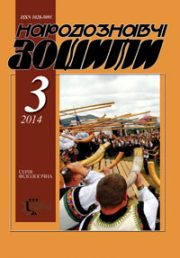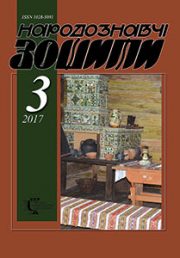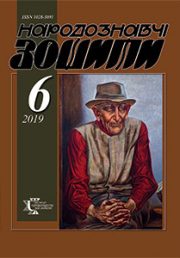The Ethnology Notebooks. 2024. № 3 (177), 686—691
UDK [[913:930.2]:2‑136.4/543.2](477.62)
DOI https://doi.org/10.15407/nz2024.03.686
THE SYMBOL OF THE BRONZE HAND OF SABAZIOS FROM THE TERRITORY OF THE UKRAINIAN STEPPE
HALAICHUK Volodymyr
- ORCID ID: https://orcid.org/0000-0001-7780-5876
- Doctor of Science in the field of History,
- Professor of the Department of Ethnology,
- Ivan Franko National University of Lviv,
- 1, Universytetska Str., 79000, Lviv, Ukraine,
- Contacts: e-mail: halay_czuk@ukr.net
Abstract. Statement of the problem. At the end of the 19th century a bronze hand was discovered on the territory of the Katerynoslav province. The signs of the find clearly indicate its belonging to the ritual objects of the cult of the Phrygian god Sabazius. To date, this is the only artifact of this type found on the territory of Ukraine.
The only study specifically devoted to this monument is the article by Boris Farmakovsky, in 1902. In 1904, Christian Blinkenberg definitively proved the connection of such hands with the cult of Sabazius. In 1983, the most complete catalog of Sabazian bronze hands with 96 items was published. During the XX — beginning 21st century a sufficient number of works appeared in which different approaches were proposed to interpret the purpose, use and symbolism of the respective monuments. It is the presence of the specified scientific achievements that determines the relevance of the application of a new approach in the study of a cult object from the Ukrainian Steppe.
The purpose of the article is an attempt, based on the achievements of world historiography, to explain the symbolism of the Sabazian hand from the territory of Ukraine.
The methodological basis of the research is provided by a combination of several methods. Systematic structural analysis, comparative historical, typological, descriptive and semantic methods were used to interpret the purpose and symbolism of Sabazius’ hands. Based on the use of comparative historical and typological methods, a list of scientific approaches relevant to the topic is outlined, their short reviews are prepared, the value and originality of the visions of certain authors is shown, and the state of their scientific knowledge is presented.
As a result of the research, several important facts were established. The bronze hand discovered on the territory of the Ukrainian Steppe is beyond any doubt a ritual object belonging to the Sabazius cult. Despite the traditional interpretation of such monuments as votive offerings to the deity by dedicants or apotropaeus, in which the power of the god himself is hidden, there is another approach. According to it, the bronze hands symbolize the process of initiation into the Sabazian mysteries and indicate the chthonic nature of these beliefs. However, due to the lack of written information about such monuments, all interpretations of their symbolism are still only hypothetical.
Keywords: history and archeology, spiritual culture, belief, bronze hand, Ukrainian Steppe, cult of Sabazios, symbolism of ritual objects, votive, apotropaeus.
Received 17.05.2024
REFERENCES
- Farmakovskii, B. (1902). Bronze votive hand from Ekaterinoslav governorate. Izvestiya Imperatorskoi Arkheologicheskoi Kommissii (Issue 3, pp. 118—121) [in Russian].
- Berndt, S. (2018). The hand gesture and symbols of Sabazios. Opuscula. Annual of the Swedish Institutes at Athens and Rome (Vol. 2. pp. 151—168).
- Vermaseren, M. (1983). Corpus Cultus Iovis Sabazii (Vol. 1: The hands). Leiden: E.J. Brill.
- Blinkenberg, Chr. (1904). Archaeological studies. Copenhagen; Leipzig [in German].
- Kobylina, M. (1978). Images of Oriental Deities in the Northern Black Sea Region in the First Centuries A.D. Moskva: Nauka [in Russian].
- Korchak, A. (2021). Bronze cult hands of roman time from the territory of Ukraine: origin and sacred purpose (according to historiography). Proceedings of History Faculty of Lviv University (Issue 22, pp. 9—27) [in Ukrainian].
- Lusthaus, D. (1947). Bronze votive handle from Myszkіw. Archeologia (Vol. 1, pp. 169—184) [in Polish].
- Lane, E. (1989). Corpus Cultus Iovis Sabazii (Vol. 3: Conclusions). Leiden; New York; Copenhagen; Сolognе.
- Kuster, E. (1913). The snake in Greek art and religion. Giessen [in German].
- Aeliani. (1832). Of the nature of animals. Seventeen books. Jenae [in Ancient Greek].
- Pliny. (1967). Natural history (Vol. III, lib. VIII—XI). Cambridge (Massachusetts): Harvard University Press.
- Toynbee, J. (1973). Animals in Roman Life and Art. Ithaca; New York: Cornell University Press.
- Aristofan. (2008). Comedy; Fragments. Moskva: Ladomir; Nauka [in Russian].







